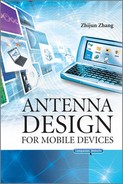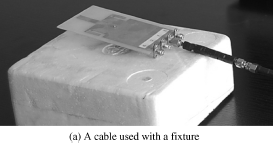Chapter 5
Antenna Measurement
So far we have discussed how to design various external and internal antennas. After making a prototype, the next thing to do is to evaluate the antenna's performance. In the process of designing an antenna, there are two kinds of antenna measurements: passive and active measurements. The passive measurements evaluate the performance of an antenna when the host device is inactive, so some means of external signal generators must be used. The passive measurements include VSWR or reflection coefficient, efficiency, gain, and so on. The active measurements evaluate the performance of an antenna when it is installed in a working device. Measurements, such as total radiate power (TRP), effective isotropic radiated power (EIRP), total isotropic sensitivity (TIS), effective isotropic sensitivity (EIS), and so on, all belong to this category. After an antenna design is rolled out to an assembly line, then various production tests are carried out. Passive production tests are carried out by antenna vendors and active production tests are implemented by phone manufacturers.
5.1 Passive Antenna Measurement
5.1.1 Measurement on a Vector Network Analyzer
The network analyzer is a piece of equipment which can measure a wide variety of parameters, such as reflection coefficient, transmission loss, and so on. The scalar network analyzers (SNA) can only measure the amplitude of various parameters. SNAs are relatively cheaper and are widely used in production lines. The vector network analyzers (VNA) can measure both amplitude and phase, which means it can display impedance on the Smith Chart. For an antenna engineer, a vector network analyzer, such as the one shown in Figure 5.1, is a necessity of life. When we tune an antenna, what we are actually doing is moving the antenna's impedance around on the Smith Chart by tweaking different parameters. With the help of a VNA, the tuning process can be conveniently visualized.
Figure 5.1 An entry level VNA, E5071C (Reproduced with permission from Agilent Technologies, Inc.)
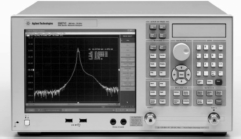
For more in-depth knowledge on VNA, refer to the “Agilent Network Analyzer Basics” [1]. Shown in Figure 5.2 is the schematic of a simplified VNA. The simplified VNA has two ports, and is only able to measure S11 and S21. There are three vector receivers inside the VNA. Each of them can measure amplitude and phase simultaneously. The R is a reference receiver. It is connected to the signal source through a power divider. Therefore, what it measures is proportional to the power flows out of port 1, which is connected to the other branch of the power divider. The A is a reflection receiver, which is connected to the port 1 through a directional coupler. The coupler is designed to only couple the power reflected from DUT and disregard the power from the port 1. The B is a transmission receiver, which measures how much power passes through the DUT and enters the port 2. Based on the measured complex values from receivers A and R, the S11 can be calculated. With values from receivers B and R, the S21 can also be obtained.
Figure 5.2 Schematic of a simplified VNA (Reproduced with permission from Agilent Technologies, Inc.)
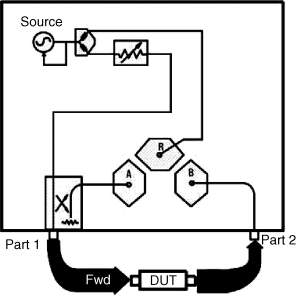
The schematic of a real two-port VNA, which can measure all four S parameters (S11, S21, S12, and S22), will be more complex. However, the principles of measurement are the same. All other parameters, such as complex impedance and group delay, can all be deduced from the S parameters.
To evaluate the matching of an antenna, both the reflection coefficient and the VSWR can be used. The reflection coefficient, another name for either S11 or S22, calculates the ratio between reflected power and total incident power. The VSWR calculates the ratio between the maximum and minimum voltage of a standing wave on the transmission line. Although their definitions are different, those two measurements are actually equivalent. The conversion formulas between them are shown in Equation (5.1).
Shown in Table 5.1 is the corresponding list between reflection coefficient and VSWR. When setting an antenna's specification, some companies like to use reflection coefficient while others prefer VSWR, so conversion is commonly done. It does not look very professional if you have to pull out a calculator every time a conversion is needed. However, it is also a little bit too much to ask somebody to memorize the whole table.
Table 5.1 Conversion table between VSWR and the reflection coefficient
| VSWR | Reflection coefficient (dB) |
| 1 : 1 | −∞ |
| 1.22 : 1 | −20.0 |
| 2 : 1 | −9.54 |
| 3 : 1 | −6.02 |
| 4 : 1 | −4.44 |
| 5 : 1 | −3.52 |
| 6 : 1 | −2.92 |
| 7 : 1 | −2.50 |
| 8 : 1 | −2.18 |
| 9 : 1 | −1.94 |
| 10 : 1 | −1.74 |
As an easy way out, only two approximate relations need to be memorized:
1. Reflection coefficient −10 dB approximately equals VSWR 2 : 1.
2. Reflection coefficient −6 dB approximately equals VSWR 3 : 1.
For a cellular antenna design, −10 dB is great. It is hard to find a reflection coefficient better than that. An antenna with −6 dB reflection coefficient is still a good one if it is an internal multi-band antenna. Depending on the project, a reflection coefficient of −4.5 dB at band edges might be acceptable. As a comparison, for big antennas, such as base station sector antennas and reflector antennas, a −20 dB reflection coefficient, which approximately equals VSWR 1.2 : 1, is normally chosen as the specification.
Although theoretically the reflection coefficient and the VSWR are equivalent, when designing cellular antennas, VSWR is better for illustrating results. The reflection coefficient puts more emphasis on the range of small reflection. For a cellular antenna, an antenna with return loss of −30 dB is not much better than a −10 dB one. However, a −6 dB antenna is noticeably different from a −4.5 dB one. Contrary to the reflection coefficient, the VSWR puts more emphasis on the range of large reflection. Any VSWR between 1 : 1 to 2 : 1 means great matching, which corresponds to a reflection coefficient range from −∞dB to −10 dB. A VSWR from 2 : 1 to ∞:1 corresponds to a reflection coefficient from −10 dB to 0 dB. To give a more intuitive example, both the reflection coefficient and the VSWR of the same antenna are illustrated in Figure 5.3.
Figure 5.3 Return loss vs. VSWR
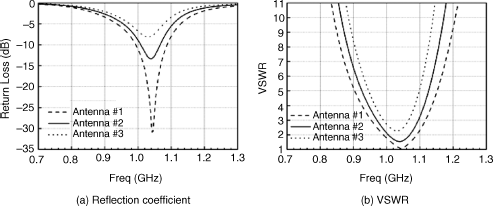
The VSWR can effectively represent an antenna's matching condition in the frequency domain, and the Smith Chart is more useful in tuning an antenna. It is very useful to be able to look at both of them simultaneously and most modern VNAs support that. There is more than one way to display both the VSWR and the Smith Chart simultaneously. Using Agilent E5071C as an example, you can use either multiple-channel mode or multiple-trace mode. However, multiple-channel mode is overkill and is inconvenient. The multi-channel mode requires a dedicated calibration and port extension for each channel. In this mode, to display both the VSWR and the Smith Chart, two separate calibrations are required. The multiple-trace mode is the one which suits antenna designing better. By selecting two traces and a horizontal-tile arrangement, the display of VNA should look like Figure 5.4.
Figure 5.4 Displaying both the VSWR and the Smith Chart on a VNA
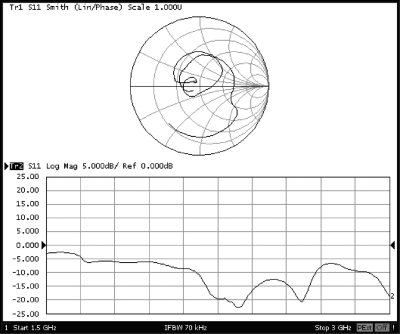
An antenna is a radiator, which means any nearby object can affect the antenna's response. So a phone fixture needs to be far from the bench's surface and be supported by a piece of foam, whose permittivity is close to 1. Shown in Figure 5.5 is such a testing set-up. To ensure a fixture is immune from nearby objects, vary the distance between a fixture and a bench by adding more foam, then the antenna's response should be stable.
Figure 5.5 A fixture connected to a VNA
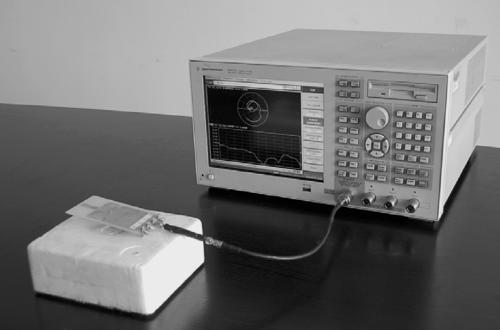
After designing an antenna, there is a trick which can give a rough idea whether the antenna works well. Sweep your hand several centimeters above the fixture, the antenna's response should synchronously fluctuate with the hand's movement. More fluctuation normally means better performance. If there is a resonance which is very stable, no matter how the hand moves, it is most likely that the resonance is an internal parasitic one, which normally does not radiate well and has very poor efficiency. As shown in Figure 5.6, the antenna's response varies with the hand's movement.
Figure 5.6 Use hand to quickly check an antenna's performance
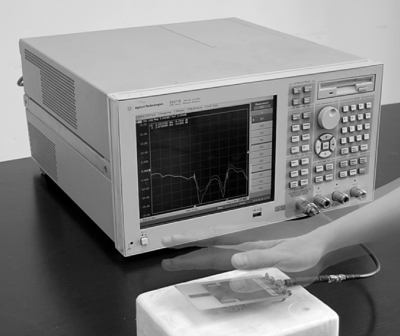
5.1.2 Fixture
Making a good fixture is an essential skill to ensure success in all antenna projects. The ultimate goal for a fixture is to duplicate an environment which is electromagnetically identical to the real phone, for an antenna under test. As has been demonstrated in the previous chapters, usually the body of a phone is also part of the radiator. Any modification required to make a fixture might move the resonant frequency or affect the matching condition. Thus it is quite critical to make a fixture which will disturb the radiation current on a phone as little as possible.
Normally, when we begin to design an antenna for a phone project, we start with a blank slate. It is important to solicit some prototype parts from mechanical engineers to start with. The following two parts are the most important ones:
1. PCB. The trace layout on the PCB is not critical. The ground pattern on the PCB is more important, because the ground is part of the radiator. All the metal in the keep-out area should be removed. At the early stage, a single-sided board is good enough for antenna designs. Extra caution must be paid if a double-sided PCB is used. The metal on both sides of the PCB must be well connected, otherwise some undesired parasitic resonance might occur.
2. Antenna support. An antenna's bandwidth and performance are highly correlated with the volume an antenna occupies. Without antenna support, it is very difficult to control an antenna's volume. A handful of samples from a machine shop should be enough at the beginning. Try to use the same plastic which the antenna is planning to use in the mass production.
Other parts, such as the phone housing, the battery, the LCD, and so on, are also important. The more parts you have, the more accurate you will be able to predict the antenna's performance, however, it can still be done without them.
If you find the first prototype antenna has 80% efficiency, don't be too excited. The efficiency will drop when you get all the real parts. If the efficiency of your first prototype is the same as the project's specification, that's not the right state to be in.
5.1.2.1 Location of Testing Cable
Because a phone is inactive when doing passive measurement, an external source must be used to carry out various measurements. To connect equipment to an antenna, some kind of transmission line is needed. At the frequency range on which the phone operates, coaxial cables are the commonly used transmission lines. Shown in Figure 5.7 are various coaxial cables.
Figure 5.7 Coaxial cables
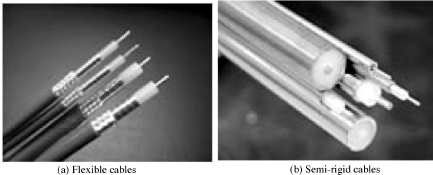
Figure 5.7a shows several high-grade flexible cables with different dimensions. The inner conductor is a solid silver-plated copper wire. Outside the inner conductor is the insulation layer, which is made of PTFE or Teflon. The outer conductor of the insulation layer is composed of two layers of metal shield. The inner shield layer is silver-plated copper tape, helically wrapped with overlap between layers. This layer is the main shielding layer. The outer shield layer is silver-plated copper wire, tightly braided over the inner shield. The braids are primarily a strength member that also adds additional RF shielding. Outside the shield layer is the jacket layer. For some cheaper coaxial cables, the outer conductor layer is composed of only silver-plated copper wire.
A semi-rigid cable, as shown in Figure 5.7b, also has inner and outer conductors separated by an insulation layer. What makes a semi-rigid cable different from a flexible cable is that it has a solid copper outer sheath. Several cables with different diameters are shown in Figure 5.7b. Semi-rigid cable offers superior performance compared to flexible cables, especially at higher frequencies. For some applications, the major disadvantage is that the cable, as its name implies, is not very flexible, and is not intended to be flexed after initial forming. However, when making a fixture, a semi-rigid cable is the best choice.
For the convenience of testing, do not make a fixture with a long cable attached. Instead, put a short pigtail cable on the fixture and use a long flexible cable to make the interconnection between equipment to the short pigtail cable. To maintain the continuity of the coaxial structure, a coaxial connector is required as the interface between a pigtail cable and a flexible cable. SMA connectors are the de facto industry standard for mobile antenna industry. Either buy semi-rigid cable and suited connector separately, then assemble them yourself or order semi-rigid cable assemblies. The SMA connectors shown in Figure 5.8 are PCB board mount-type connectors. They are supposed to be soldered to a board directly. The one with a pin at the center is the male type. The other one with a hole in the middle is the female type.
Figure 5.8 SMA connectors

Shown in Figure 5.9a is an IFA antenna model used in simulations. All gray areas are metal surface. The small area, which is marked by a dash circuit and magnified in the insert, is a lumped port. A voltage source is used at the port to feed the antenna. Shown in Figure 5.9b is a prototype of the IFA antenna. A semi-rigid coaxial cable is used as the feeding transmission line. The detail of the feeding structure is magnified in the insert. The end of the coaxial cable's outer conductor is soldered to the edge of the ground plane and the inner conductor is soldered to the antenna. The whole coaxial cable is placed on top of the ground plane and soldered to the ground at many points. When a signal travels along the cable, all the currents and electromagnetic field are constrained inside the cable. There is no current on the outside surface of the outer conductor and thus no radiation. At the open end of coaxial cable, the current on the inner conductor flows to the antenna and the current on the outer conductor flows to the ground. As the end of coaxial cable is connected across the gap, it is equivalent to a voltage source over the gap, just like the voltage source used in Figure 5.9a.
Figure 5.9 Making a prototype

In Figure 5.9b, at the opposite end of the semi-rigid cable there is a SMA connector. The connector is placed on the right side. Actually, the connector's position is not selected arbitrarily, it is optimized to minimize the intrusion effect of a testing cable.
For most cellular antennas, the ground is part of the radiator. There are strong electromagnetic fields and current distributions on the ground. If the position of the pigtail connector is not well chosen, currents on the ground can leak to the testing cable. As a testing cable is much longer than the ground, the cable becomes a radiator by itself.
Let's use the dual-band antenna shown in Figure 5.9 as an example to explain how to select a position for a pigtail connector. There are four edges on a ground plane. Edge #1 is adjacent to the antenna element, putting anything here will strongly affect the antenna's response. Edge #3 is the furthest edge of the antenna, so some people might think this edge is the best choice. However, it isn't. The length of ground can affect an antenna's response, especially at the lowest band. More discussion on the impact of a ground on an antenna's response can be found in Section 3.4. On edge #2, there are strong currents at both low and high bands. Of all four edges, edge #4 is the best location for the connector.
In practice, the exact location of the connector is decided by trial and error. You can put the connector at a location of your best guess; connect the fixture to a network analyzer through a flexible cable; use your hand to touch the connector and different spots along the PCB's edge, check the antenna's response at the same time. The ideal location for the connector is where the antenna's response does not change at all when your hand touches it. That ideal location may not exist, so just pick a location which provides the most stable response across all interested bands. A choke, which will be discussed later, can be used to take care of the residual effect.
Shown in Figure 5.10 is a fixture which has some improper details. The spot A, which is the end of coaxial cable, must be soldered to the ground. Without that solder point, the current has to flow on the outer surface of the cable until it reaches the first solder point. That is equivalent to adding a series inductor into the feeding line and can distort the antenna's real response, especially at the higher band. The inner conductor marked at spot B is too long and it also adds parasitic series inductance to the antenna's response. The length of the pigtail, which extrudes out of the PCB, at spot C is a little longer than necessary. If an ideal sweet spot for the connector can be found, in theory, the length of the pigtail should not affect the antenna's response. In reality, more or less, the connector still has some impact, so it is good practice to keep that length as short as possible.
Figure 5.10 A fixture with improper details
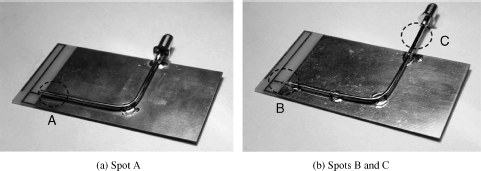
When making a fixture out of a real phone, it is important to figure out where to disconnect the transceiver and tap the semi-rigid cable in. For the primary antennas, there is always a connector, usually, there is a switch connector, between an antenna and a transceiver. Due to production variations when making a phone, a phone must go through a tuning and calibration process to be compliant with various requirements on safety and performance. Shown in Figure 5.11 is a switch connector. In a normal operating mode, the signal just passes through the connector. When a probe is plugged in, it disconnects one side and makes contact with the other side. In a phone, the connector disconnects an antenna, so various pieces of equipment can make accurate measurements on the transceiver.
Figure 5.11 Switch connector (Reproduced from Murata Manufacturing, Co., Ltd.)
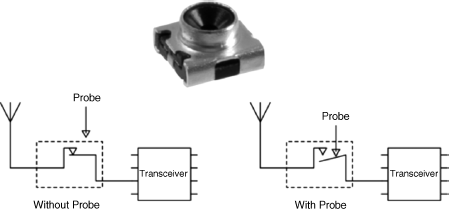
The PCB area of a switch connector is an ideal tapping point for a semi-rigid cable. Switch connectors are coaxial connectors, so they have both inner and outer conductors. Naturally, the solder pads of a switch connector on a PCB are always readily routed to both signal and ground. All ports of a switch connector are designed as 50 Ω, that means all transmission lines connected to a connector have a characteristic impedance of 50 Ω. When making a fixture, we just remove the connector with a hot gun and put the cable in, and then we are all set.
For some auxiliary antennas, such as GPS antennas or WLAN/BT antennas, there is no switch connector on the PCB. As the specifications for those applications are quite loose, no tuning process is needed. However, even in such circumstances, the antenna is still connected to the chipset by a 50 Ω transmission line. In some cases, the 50 Ω line terminates at the transceiver chip, which can be removed to make space for a pigtail cable. In other cases, a transceiver has a balanced RF port and a balun is used to convert a single end signal to a balanced one. In such cases, the balun needs to be removed and the pigtail cable must be tapped to the single end 50 Ω line.
5.1.2.2 Choke and Ferrite Beads
When making a fixture, it is not always possible to put the pigtail cable at the ideal location. A phone's PCB is populated with various integrated circuits, shielding boxes, board-to-board connectors, and so on. It is not good practice to significantly modify the PCB, as it might change the radiation property of the PCB. When a testing cable is attached to the pigtail of a fixture, some residual current will flow on the surface of the cable. That may affect an antenna's frequency response, radiation pattern, and efficiency.
To mitigate the current on the cable, some kind of RF choke should be used. Shown in Figure 5.12 is a sleeve choke. The choke is formed by several series of arranged metal cylinders. One end of each cylinder is soldered to the outer conductor of a coaxial cable. This kind of choke is not reciprocal and can only be connected to a fixture in one direction.
Figure 5.12 Sleeve choke
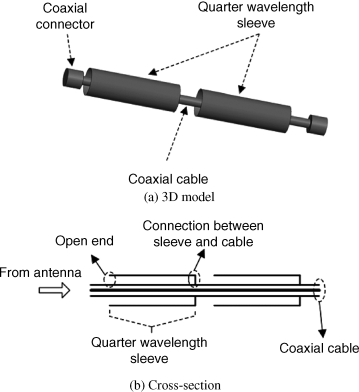
Shown in Figure 5.12b is the cross-section of a sleeve choke. The metal sleeve and the outer conductor of coaxial cable form another coaxial structure. For current flows on the cable's outer surface, this coaxial structure functions as a transmission line. The further end of the sleeve, which is referred to the antenna side, is connected to the outer conductor of coaxial cable. This connection is equivalent to a short circuit for the sleeve structure. The length of sleeve is one quarter of a wavelength. Based on the transmission line theory, a short circuit becomes an open circuit after one quarter of a wavelength. At the open end of the sleeve, it becomes an open circuit and the current here should be zero. In reality, although most currents are choked at the first sleeve, some residual currents still pass though. A few more sleeves are used to further reduce the surface current on the cable.
The sleeve choke shown in Figure 5.12 is a single band choke. As the effectiveness of current suppression is related to the quarter wavelength, the frequency band of the choke is quite narrow. To cover different bands, chokes of different dimension are required. Some studies [2–4] on how to make multi-band chokes have been done, but they are quite complex and seldom used in practice.
Nowadays many antennas are multi-band, so it is preferable to use a wideband choke instead of several narrowband ones. Shown in Figure 5.13 are some ferrite bead chokes. Ferrite chokes are produced mainly for EMI purposes. As the cable radiation in antenna measurements is basically the same as the EMI radiation, some means of suppression can be used. Just as its name implies, ferrite chokes are made of ferrite material. There are two commonly used ferrite material: manganese-zinc (Mn-Zn) and nickel-zinc (Ni-Zn). Mn-Zn ferrite chokes are used in 1–30 MHz. The marked working frequency for Ni-Zn chokes can be up to 1 GHz. Mobile communication starts at hundreds of megahertz, so only Ni-Zn chokes can be used.
Figure 5.13 Ferrite bead choke

Ferrite material has very high permeability (μ), which ranges from hundreds to thousands. The inductance L of a piece of wire is directly correlated to the permeability of the surrounding material, and the surface impedance is defined by j2πfL, where f is the working frequency. Based on the above relations, a ferrite choke should have a better suppression effect at a higher frequency. That is only half correct, because the permeability of ferrite material is not a constant but a variable of frequency.
Shown in Figure 5.14 is the measured data of Round Cable EMI Suppression Core 2661023801 made by Fair-Rite Inc. Below tens of megahertz a wire with ferrite choke appears to be pure reactance, which is lossless. Between the tens of megahertz and hundreds of megahertz frequency range, the wire becomes lossy, so it functions as an inductor in series to a resistor. In the middle of this frequency range, while the resistance keeps increasing, the reactance starts to decrease. Around 600 MHz the reactance part of a ferrite choke becomes so small that it functions mostly as a resistor. At the highest frequency, the resistance will also start to decrease.
Figure 5.14 Impedance, reactance and resistance vs. frequency (EMI Core 2661023801) (Reproduced from Fair-Rite Products, Corp.)

To function as an ideal choke, the choke should be pure reactance. When there is resistance portion in the total impedance, the choke becomes lossy and consumes power, thus making the measured antenna's efficiency worse than it actually is. In some engineers' opinion, as ferrite chokes are specified as 1 GHz components, they should not be used above that frequency. Other engineers think differently. They think this kind of ferrite chokes can be used in all mobile communication bands, which is up to 2.17 GHz. The author supports the later opinion. The following are several arguments.
Although the ferrite chokes become quite lossy at high frequency, the impedance is still relatively high. The power consumed by a ferrite choke is proportional to ![]() . The E field at the connector spot is less than the E field at the antenna feeding. As the R is also much larger than the antenna's impedance, the total impact on the antenna's efficiency is reasonable. As discussed in the last section, the connector position must be carefully selected so the current leak to a cable is as little as possible. The ferrite choke only serves as an auxiliary means to mitigate residual current on a cable. So even if the ferrite chokes absorb all the currents instead of stopping them, it shouldn't degrade the antenna efficiency too significantly. On the other hand, lossy chokes can still provide a stable condition for antenna measurement that is much better than shooting a moving target. As the chokes always make the antenna efficiency worse, so it is safe to use the value measured with chokes, which inherently provide a safety cushion, and we can be certain that the real value must be better. A lossy choke might change the frequency response of an antenna, so at the later stages when doing active antenna measurements, when the testing cable is no longer an issue, a batch of slightly differently-tuned antennas should be measured to capture the optimum parameters for the final production antenna.
. The E field at the connector spot is less than the E field at the antenna feeding. As the R is also much larger than the antenna's impedance, the total impact on the antenna's efficiency is reasonable. As discussed in the last section, the connector position must be carefully selected so the current leak to a cable is as little as possible. The ferrite choke only serves as an auxiliary means to mitigate residual current on a cable. So even if the ferrite chokes absorb all the currents instead of stopping them, it shouldn't degrade the antenna efficiency too significantly. On the other hand, lossy chokes can still provide a stable condition for antenna measurement that is much better than shooting a moving target. As the chokes always make the antenna efficiency worse, so it is safe to use the value measured with chokes, which inherently provide a safety cushion, and we can be certain that the real value must be better. A lossy choke might change the frequency response of an antenna, so at the later stages when doing active antenna measurements, when the testing cable is no longer an issue, a batch of slightly differently-tuned antennas should be measured to capture the optimum parameters for the final production antenna.
Shown in Figure 5.15a is a fixture with some ferrite chokes attached to effectively suppress the surface current on the cable. A 10 cm long tightly packed ferrite beads should be enough to isolate the measurement cable. You can check the effectiveness of the choke by touching the measurement cable with your hand. With or without a hand, the measurement value should always be stable.
Shown in Figure 5.15b is a flexible cable with some ferrite chokes sparsely attached. This kind of cable is used in anechoic chambers. For a chamber used for measuring high gain antennas, an untreated cable is fine. Because the cable can be routed on the back of the antenna and placed in the shadow of sidelobes, the measurement error introduced by the cable is negligible. On the other hand, all mobile communication antennas are low gain antennas. That means these antennas radiate in almost all directions. If a long untreated cable is used in the chamber, some electromagnetic energy will be picked up by the cable and re-radiate back to the space, which causes measurement error. By putting ferrite chokes on a cable, the long metal object is divided into discrete small segments, if considered from the electromagnetic point of view. Each segment is much shorter than a wavelength, thus it is transparent to the electromagnetic wave. As the cable is not immediately adjacent to a phone fixture, the coupled current on the cable is quite weak, so it is not necessary to use tightly packed ferrite chokes as shown in Figure 5.15a. To suppress secondary radiation from a test cable, whether a ferrite choke is lossy or not is no longer a concern. As long as a ferrite choke can kill the surface current, it is qualified.
In conclusion, traditional sleeve chokes have pretty good characteristics in a relatively narrow bandwidth. They were popular when most antennas were single band ones. Nowadays, if you need to use a choke, the best option is a ferrite choke. As different ferrite materials have different specifications, you might have to use two or three ferrite chokes with different dimensions and frequency characteristics to cover an ultra-wide bandwidth, say, from 800 MHz to 6 GHz.
However, those who are not convinced that ferrite chokes can be used at high frequency can live without a choke. Just make sure that the pigtail connector is located at an optimal location which can minimize the impact of a measurement cable.
5.1.2.3 Port Extension
Before we can use a VNA, normally we need to calibrate it first. The calibration process used to be quite cumbersome and required multiple standards, such as OPEN, SHORT, LOAD, and so on. For more on the principle of calibration, some application notes [5, 6] from Agilent Inc. are quite helpful. Nowadays, the calibration can be done with an E-Cal module, shown in Figure 5.16, which is pretty much foolproof. After the calibration, the reference plane of the VNA is set to the end of the flexible cable. If we only want to know whether an antenna works well, a calibrated VNA can provide an accurate measurement. If we need to tune an antenna or design a matching network, we need one more stage: port extension.
Figure 5.16 E-Cal Module N4431-60003 (Reproduced with permission from Agilent Technologies, Inc.)

Shown in Figure 5.17a is the schematic of a test fixture. The impedances shown in Figures 5.17b and c are results of the same dual-band antenna using different reference planes, one at the calibration plane and the other at the antenna feed. The complex impedances of two measurements are totally different. As discussed in Chapter 2, when designing a matching network, the topologic of a matching circuit depends on its original impedance, whether it is capacitive or inductive. If the measured complex impedance is wrong, it is impossible to design the matching circuit correctly. The difference between two results is caused by the pigtail cable between the two reference planes. As we know, a transmission line can clockwise rotate any impedance on the Smith Chart. The impedance moves a full circle on the Smith Chart for every half-wavelength. For a wideband or a dual-band antenna, the cable's electrical length varies significantly at different frequencies, thus an antenna's impedance curve is spread widely on the Smith Chart.
Figure 5.17 Impedance of a test fixture

When we design an antenna, what we want to know is the complex impedance at the feeding point or at the matching circuit. To move the reference plane from the calibration plane to the antenna feed, a port extension function is required. Fortunately, most VNAs have a port extension as a built-in function, which moves the calibration reference plane by specifying the electrical delay. Mathematically, the effect of a pigtail cable on an antenna's impedance can be expressed by Equation (5.2):
where l is the length of the pigtail cable, λ is the wavelength, ![]() is the actual antenna impedance, and
is the actual antenna impedance, and ![]() is the measured impedance. What a port extension does is multiply
is the measured impedance. What a port extension does is multiply ![]() by a
by a ![]() factor, so
factor, so ![]() can be restored.
can be restored.
Shown in Figure 5.18 is the screenshot of the port extension menu of an Agilent VNA E5071B. It is underCalPort Extension. A port extension can be carried out separately on each port. VNAs from different manufacturers may have different menu arrangements. Some VNAs even have an automatic port extension function. You should refer to the respective user manual accordingly. As shown in Figure 5.18, five steps are required to properly set the port extension on an E5071B.
Figure 5.18 Port extension interface

The unit used in port extension can be either length or time, which means how long the pigtail cable is or how much time an electromagnetic wave needs to travel through the cable. You should never measure the length of a cable by a ruler, then manually input the value. The inherent assumption used here is that the cable is air-filled and a signal travels at the speed of light in vacuum. As the semi-rigid cable used in a fixture is filled with dielectric material, the assumption is not valid. In practice, a port extension has two steps. First, we disconnect the antenna and make a short circuit at the feed or the matching circuit. In the second step, we adjust the port extension value until the whole impedance curve is concentrated into a tiny area around the zero impedance point on the Smith Chart. If the frequency band is quite wide, say, from 800 MHz to 6 GHz, the impedance curve may spread a little bit. That is normal.
If you have several fixtures, each fixture must have their own port extension value. A good way to avoid making mistakes is to save the setting of each fixture in a separate file. Each time before you start testing, load the setting file for the specific fixture. If a choke is used with a fixture, the choke should be attached to the flexible cable when doing the calibration and port extension, as the choke also has a certain length. It is good practice for each engineer to have a dedicated choke. That avoids the potential error caused by different choke lengths.
5.1.3 Passive Chamber Measurement
The best environment to measure an antenna's efficiency is in free space. However, this is not practical, so the anechoic chamber was introduced. “Anechoic” means nothing bounces back from the chamber wall. In an ideal anechoic chamber, all electromagnetic wave travels outward and nothing is reflected back, which is just what will happen in free space. An anechoic chamber is a metal shielding room with all the internal surfaces covered with radiation absorbent material (RAM). The RAM can absorb most incident electromagnetic waves. Detailed information of anechoic chamber technology can be found in books [7–9]. Only the essential knowledge is introduced here.
Shown in Figure 5.19 are a rectangular and a tapered chamber. Both of them are widely used in the mobile phone industry. In most chambers, the transmitting horn antenna and the device under test are located along the axis of the longest dimension. In Figure 5.19b, the cone on the end of tapered section is the transmitting horn and the antenna under test is at the center of the rectangular section. Compared with the tapered chamber, the rectangular chamber is more compact and its construction cost is less. However, its working frequency range is narrower and its overall electrical performance is also inferior.
Figure 5.19 Two kinds of chambers (Reproduced with permission from ETS-Lindgren Inc.)

The RAM is designed and shaped to absorb incident RF radiation, as effectively as possible, from as many incident directions as possible. Based on the principle of physics, at an interface of two different dielectrics, some portion of an incident electromagnetic wave will be reflected and some of it will pass through. The reflection coefficient depends on the difference between the dielectric properties of two dielectrics. The larger the difference, the more reflected energy there is. As the whole purpose of RAM is to absorb incident energy instead of reflecting it, we must minimize the difference between two dielectrics. The dielectric on one side is air, which has a permittivity of 1. On the other side, the absorbing material is made of rubberized foam, which is composed of a large amount of air and its permittivity is close to 1. Some people might think that the absorber is made of solid plastic or rubber, but now it is obvious why it cannot be.
To function as an absorber, low permittivity is not the only requirement. The RAM must have appropriate lossy characteristics. The RAM needs to adequately attenuate the electromagnetic wave before the wave reaches the metal shielding wall behind it, where the wave gets reflected back. By doping rubberized foam with controlled mixtures of carbon and/or iron, the desired absorbing property can be achieved.
Shown in Figure 5.20 are two commonly used absorbers. One is pyramid shaped and the other one is wedge shaped. The wedge absorber has been used in the tapered chamber shown in Figure 5.19b. You should be able to see them in the tapered section of that chamber.
Figure 5.20 Radiation absorbent material (Reproduced with permission from Microwave Vision SA.)
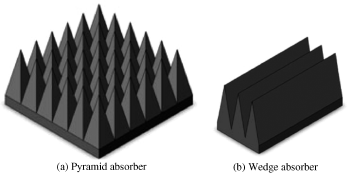
Now let's explain why the absorber has such a weird form factor. Although the RAM is designed to have as little reflection as possible, there is still some residual reflection. For a normal anechoic chamber, the reflection from the wall should be less than −40 dB, which is well below a flat RAM's reflection level. By forming the RAM into a wedge shape as shown in Figure 5.21, most reflected energy bounces into the surface of the adjacent cone or ridge. Each time the electromagnetic wave hits an interface, most of the energy will penetrate into the RAM and be attenuated. After several bounces, only a tiny portion of the incident energy is still left.
Figure 5.21 How an absorber works
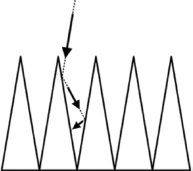
A pyramid absorber can be used in any location in a chamber. A wedge absorber can only be used when the incident plane of wave approximately aligns to the wedge's edge. If the incident wave is orthogonal to the edge, the reflection from the absorber will increase due to the diffraction from the edge. An absorber has the best absorbing capability when the wave incidents come from the normal direction. The case shown in Figure 5.21 is such a good working condition, which has large incident angle. The effectiveness of an absorber starts to decrease when the incident angle gets smaller. At small incident angle, a wedge absorber always has better performance than a pyramid one. If we revisit the tapered chamber shown in Figure 5.19b, it should be clear why the wedge absorber is used at the tapered section.
The thickness, which is from the tip to the base, of an absorber is decided by the wavelength of its lowest working frequency. For an absorber working in a frequency as low as 800 MHz, the height is around 30∼40 cm range. Of course, the bigger absorber is always better, but it also costs more.
Because the absorber is doped with carbon, its natural color is black. A layer of paint, normally blue, is sprayed on the surface of absorbers to increase their light reflection. Without that layer of paint, an anechoic chamber would be too dark to work in.
Shown in Figure 5.22 is a standard test set-up in a 2D chamber. A dual-polarization horn antenna serves as the transmitting antenna. A phone fixture, which is installed on a rotation table, serves as the receiver. As the system is reciprocal, so the measured value should be the same if the phone serves as the transmitter and the horn as the receiver. A network analyzer, which measures the transmission loss between the horn and the phone fixture, is at the heart of the measurement system.
Figure 5.22 Simplified block diagram of a 2D test set-up
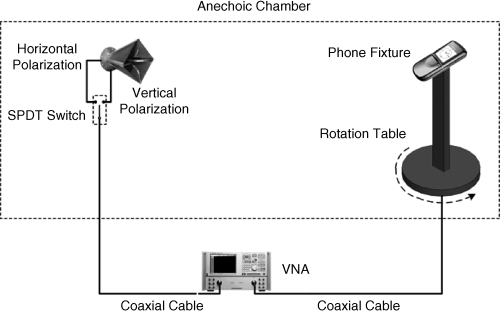
To evaluate an antenna, radiation patterns of both horizontal and vertical polarization must be measured. For most chambers used in the phone industry, the dual polarization horn is the standard. A single-pole double-throw (SPDT) switch can be used to change between two polarizations. For chambers which require wider bandwidth and better polarization purity, single polarization horns are normally used. In such a system, the phone fixture must be measured twice with the horn rotated 90° between measurements. In a dual-polarization horn, the pair of vertical ridges generates the vertical polarization. The horizontal ridges correspond to the horizontal polarization.
A 2D chamber is very useful for measuring high gain antennas, such as reflector antenna and an array antenna. However, in the phone industry, the 3D chamber is the standard. Several measurements, which are required in the process of certification, must be carried out in a 3D chamber. Shown in Figure 5.23 is a 3D chamber. The only difference between a 2D chamber and a 3D chamber is the rotation table. On a 3D rotation table, a phone fixture can rotate in the azimuth plane and it can also revolve around itself.
Figure 5.23 Simplified block diagram of a 3D test set-up
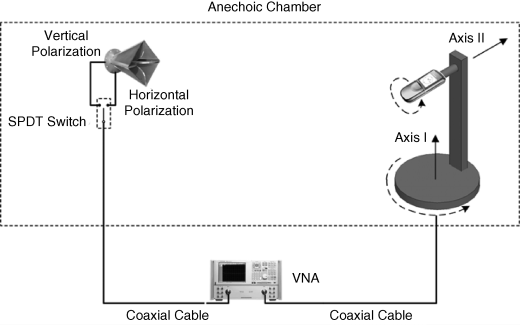
The coordinates' definition in a 3D chamber might be very confusing. For most far field 3D chambers on the market, the Axis II is the Z axis. Rotation around Axis I corresponds to the elevation angle θ and around the Axis II corresponds to the azimuth angle ϕ. When measuring a 3D radiation pattern, the rotation table rotates around the Axis I from 0° to 180° and the rotation arm revolves around the Axis II between 0° and 360°. The moving speed of the whole rotating table and the rotating arm is quite different. By distributing most movement to Axis II, the total measurement time can be minimized. In a 3D chamber, the definition of a horn's polarizations also changes. The vertical E field actually corresponds to the horizontal polarization and vice versa.
Shown in Figure 5.24 is the measurement sphere of the phone shown in Figure 5.23. The sphere is also called the “conical” cut sphere. The moving step of Figure 5.24 is 15°. The circles around the sphere are the measurement paths. For each turn around the Axis II, the measurement path is a full circle on the sphere. On each circle, there are evenly distributed test locations, which are also 15° apart from each other and are not marked in the figure. At each test location, an antenna's responses to both horizontal and vertical polarizations are measured.
Figure 5.24 Measurement 3D sphere (15° step)
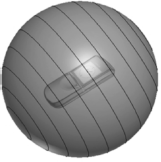
Both 2D and 3D chambers discussed above are far field chambers. It means that the distance between the horn and the phone fixture is far enough, and the sphere wave at the fixture can be approximated by a planer wave. Shown in Figure 5.25 is a near-field chamber [10], which is normally known as the Satimo chamber. The raw data measured by a Satimo chamber is near-field data. A computer code is used to transform near-field data to a far-field result.
Figure 5.25 Near field chamber (Reproduced with permission from Microwave Vision, SA.)

One unique feature inside a Satimo chamber is the arch. The arch is composed of an array of probes, which are evenly distributed on the circumference and wrapped by absorbing material. Each probe can detect two orthogonal polarizations. The white column in the middle, which is made of foam, is to support phone fixtures. In Figure 5.25a, horn antenna was placed on the support as the device under test. A testing cable runs through the middle of the column to connect fixtures. In a Satimo chamber, the horizontal plane is the azimuth one and the vertical plane is the elevation one. To get a pattern of elevation cut, the system only needs to electronically scan the array of probes. To get a full 3D pattern, the system rotates the foam column from 0° to 180° and scans the probes accordingly. As electronic scanning is faster than a mechanical scanning, the primary scanning plane is the elevation plane.
Shown in Figure 5.26 is the measurement sphere of a Satimo chamber. The moving step is 15°. The sphere is also called the “great circle” cut sphere. This measurement sphere is more intuitive. The 3D spheres shown in Figures 5.24 and 5.26 may seem different; the actual test locations on both spheres are identical. The only difference is the measurement path which connects all test locations.
Figure 5.26 Measurement 3D sphere of a Satimo chamber (15° step)

Both kinds of chambers can be qualified to carry on CTIA certification tests [11], which means they have adequate accuracy. In normal operation, a multi-probe system is faster when doing measurement. However, a multi-probe system must be calibrated more frequently, as it has more probes and is more sensitive to environment variation, such as temperature fluctuation. On the other hand, a standard far field chamber is more stable, but it also takes more time to do the measurements.
A 3D passive anechoic chamber can measure various antenna parameters, such as efficiency, gain, axial ratio, beamwidth, and so on. All those parameters are deduced from the same set of measured raw data. Of all the parameters, efficiency is the most important one for a cellular antenna. The efficiency definition used in the cellular antenna industry is shown in Equation (5.3).
Efficiency is defined by the ratio between the total radiated power and the available power at the mating connector of the testing cable. The efficiency value includes the contribution of the impedance mismatch loss, the matching circuit loss and the conductive and dielectric loss from the antenna and the phone structure. Besides using percentage (%) as the unit when referring to efficiency, dB is also widely used. Shown in Table 5.2 is the corresponding list.
Table 5.2 Conversion table of efficiency between percentage dB
| Antenna efficiency | |
| (%) | dB |
| 25 | −6 |
| 50 | −3 |
| ∼80 | −1 |
| Source: [0,1,2]. | |
In the cellular phone business, 50% or −3 dB is the gold standard for the antenna efficiency. When a project is accomplished, if the antenna has efficiency better than −3 dB across all bands, you have reason to smile. In some literatures, you might see authors claim antennas' efficiency better than 95%. The efficiency definition they used, which does not include mismatch loss, is a legitimate one but is different from Equation (5.3).
Besides efficiency, gain is the other frequently used parameter to describe an antenna's electrical characteristic. However, gain is not really important when designing cellular antennas, as it is not solely decided by antennas. Comparing the antenna gain of different phones is not important. In the cellular application, as a phone's orientation and base stations' locations are all arbitrary, high gain antennas do not necessarily mean better performance. When an antenna has higher gain in a certain direction, it must have deeper null in other directions. As there is no way to continuously point the peak of antenna's radiation pattern toward a base station, the overall system performance of a high gain antenna is actually worse. As a rule of thumb, as the radiation pattern at lower band is more uniform, the lower band's gain is always less.
When both a phone's form factor and its antenna's shape have been determined, the gain of the antenna is highly correlated to its efficiency. To measure an antenna's efficiency, a 3D pattern data must be collected, which is quite time-consuming. As an alternative, measuring gain is a better way when you need to assess several antenna samples. For an antenna with known radiation peak, you can use chamber software to point the peak toward the testing horn antenna. The peak gain of most cellular antennas is quite low, which means the pattern's beamwidth is wide, which in turn means the gain measurement is not sensitive to slight positioning variations. To assess 20 antenna samples, the efficiency measurement needs a few hours to half a day, the gain measurement can be accomplished in several minutes. There is a precondition when using the gain method to substitute efficiency measurements, which is that normalized patterns of all antenna samples must be consistent. If a phone has intermittent connection between metal objects, the radiation patterns might change between tests. In such circumstances, the efficiency measurement may be the only reliable method.
5.2 Active Antenna (OTA) Measurement
In a passive antenna measurement, an antenna is isolated from the active system, which gives us a clean environment to design, debug, and optimize the antenna. The passive measurement is a component level test. As a product, cellular phones are always evaluated by customers as a whole. A customer is not really interested in how well an antenna works. Similarly, cellular phone service providers only evaluate each phone as a whole system. The active antenna test, which is often referred as the Over the Air Performance Testing (OTA Performance Testing), is the system-level chamber test accepted by service providers. OTA tests determine how a specific network will influence the connectivity performance of a mobile handset. The tests reduce the need to perform field tests for connectivity and also allow operators to rapidly evaluate new products.
Different standard organizations have released several versions of OTA test guidelines. Of them, the US-based CTIA – The Wireless Association, was the first to set up the test framework [12]. CTIA stands for Cellular Telephone Industries Association, it changed its name to “CTIA – The Wireless Association” in 2004 to better represent the expanding wireless industry. Europe's 3GPP/ETSI also has a version of the OTA test standard [13]. The 3GPP stands for Third Generation Partnership Project. ETSI stands for European Telecommunications Standards Institute. As most 3GPP's standards are identical to ETSIs, they are normally counted as one. Both CTIA and 3GPP/ETSI are international organizations. In some countries, domestic versions of the OTA test standard are used. Using China as an example, the “YD/T 1484-2006 Measurement Method for Radiated RF Power and Receiver Performance of Mobile Stations” is the official standard.
From the technical point of view, all those standards are pretty much the same. Some differences, which are technically insignificant, are deliberately introduced for political reasons. In this section, the principle of measurements is the emphasis. For more information, refer to the corresponding documents [12, 13, 14].
5.2.1 EIRP, ERP, and TRP
Effective isotropic radiated power (EIRP), effective radiated power (ERP), and total radiated power (TRP) are all parameters used to evaluate a cellular phone's performance as a transmitter. The unit normally used is dBm, which is an abbreviation for the power ratio in decibels (dB) of the measured power referenced to one milliwatt.
Shown in Figure 5.27 is an illustration of EIRP. Assume there is a 0 dBm signal radiated from an isotropic antenna and it travels outward in an ideal free space. Obviously, the isotropic assumption is a theoretical one, as there is no such antenna in the real world. At a given distance R, the theoretical received signal from the isotropic antenna is X dBm. Now replace the isotropic antenna with a phone, if the power of the received signal increases by 3 dB, the EIRP of the phone at that angular direction is 3 dB above 0 dBm, which equals 3 dBm. The EIRP is a relative measurement, so no matter what distance R is, the EIRP of a phone is always the same.
Figure 5.27 Illustration of EIRP
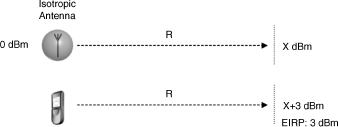
As a phone is not isotropic, the power it radiates towards different directions is also different. As a result, a phone's ERIP is a variable which depends on the test direction and a phone's orientation. However, usually when people refer to EIRP, it actually means peak EIRP. The relation between a device's peak EIRP, conductive power and gain can be written as:
The conductive power is the power available at the switch connector. Based only on a phone's peak EIRP, we are not able to tell how good the antenna is. It is possible to get the same peak EIRP by increasing the conductive power of a phone which has a low efficiency antenna.
ERP is pretty much the same as EIRP, except it uses a half-wavelength dipole as the reference antenna instead of an isotropic one. ERP is numerically 2.14 dB, which is the gain value of a dipole antenna, less than EIRP. Some people might wonder why we need both ERP and EIRP. This is for historical reasons. In the 2D chamber era, dipoles were normally used as the calibration standard, calculating ERP from the difference between an antenna and a dipole is a little bit easier than calculating EIRP. After the wide adoption of 3D chambers, the EIRP is more frequently used. It is a strange phenomenon that some service providers use ERP as the 850 MHz band specification and EIRP as the 1900 MHz band one. Their aim is to make the specification back-compatible. The history between ERP and EIRP is analogous to that between dBd and dBi.
Today, the most frequently used parameter for evaluating transmitter is neither ERP nor EIRP, it is TRP (total radiated power). Just as its name implies, the TRP represents how much power a phone radiates into free space. It is the integral of the EIRP over the surface area of a hemisphere:
(5.5) 
where ![]() and
and ![]() are Theta and Phi polarizations of EIRP. The Theta polarization is also called the vertical polarization and the Phi one is called the horizontal polarization. The units of both are absolute power. In the real world, TRP is calculated from discrete measurement data. For a complete sphere measured with N Theta intervals and M Phi intervals, both with even angular spacing, the TRP can be written as:
are Theta and Phi polarizations of EIRP. The Theta polarization is also called the vertical polarization and the Phi one is called the horizontal polarization. The units of both are absolute power. In the real world, TRP is calculated from discrete measurement data. For a complete sphere measured with N Theta intervals and M Phi intervals, both with even angular spacing, the TRP can be written as:
(5.6) 
In the CTIA test plan, the angular step of a TRP test is 15°. No data need be recorded at positions corresponding to Theta = 0° and 180°, nor at positions corresponding to Phi = 360° (Phi = 0° data are recorded), because those points are not used. For transmit tests with N = 12 and M = 24, this means that only 11 Theta cuts and 24 Phi cuts, or 264 measurements in each polarization, need be taken.
Besides the integral formula, there is a more intuitive way to define TRP:
The unit of TRP here is dBm. The difference between the conductive power and the TRP is the antenna efficiency. TRP is always lower than the conductive power. Now it is clear why people like to use dB as the unit when talking about an antenna's efficiency. When a project manager breaks down a phone's specification, the starting point is the TRP, which is provided by various service providers as a mandatory requirement. The ![]() is the sub-specification for RF engineers who are responsible for transceivers. The efficiency is for antenna engineers. Of course, project managers always reserve some “mark up” for themselves, in case something goes awry. The actual target is higher than the mathematically calculated one.
is the sub-specification for RF engineers who are responsible for transceivers. The efficiency is for antenna engineers. Of course, project managers always reserve some “mark up” for themselves, in case something goes awry. The actual target is higher than the mathematically calculated one.
There are two other parameters [12], NHPRP ±45 and NHPRP ±30, which are included in CTIA format reports but receive little attention from antenna engineers. HRP stands for Near-Horizon Partial Radiated Power. One integrates EIRP between ±45°, the other one between ±30°. They can be calculated from the same set of test data used by the TRP formula.
(5.8) 
Shown in Figure 5.28 is a TRP test set-up. In a TRP test, a phone is installed on the 3D rotation table without any cable attached. A base station simulator, which can establish a live connection with the phone and set the phone to the maximum transmitting power, is connected to a link antenna near the phone. The equipment which carries on the actual power measurement is a spectrum analyzer. The power of both the vertical and horizontal polarization fields is measured by switching a SPDT switch. In this set-up, the position of the link antenna and the transmitting power of base station simulator are not important, as long as they can keep the wireless link connected during tests. As most phones are linear polarized, a circular polarized log spiral antenna is used as the link antenna in the test configuration shown in Figure 5.28. If a linear polarized antenna is used as the link antenna, the connection might break when the phone under test and the link antenna are cross-polarized.
Figure 5.28 Simplified block diagram of a TRP test set-up
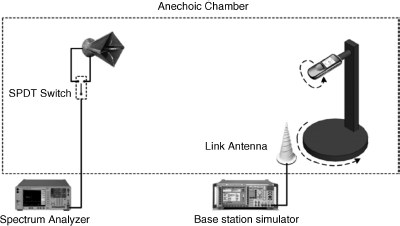
The actual TRP specification depends on many factors, the following are a partial list:
- Service providers: Vodafone, Verizon, AT&T, China Mobile, and so on.
- Technologies: AMPS, GSM, CDMA, WCDMA, CDMA2000, and so on.
- Bands: 850 MHz, 900 MHz, DCS, PCS, UMTS, and so on.
- Contents: voice, data, and so on.
- Configurations: flip open/close, slide up/down, antenna extended/retracted.
- Positions: free space, with phantom head, with both phantom hand and head.
Normally, only low, middle, and high channels are measured at each band. Depending on which market the antennas are being designed for, the TRP specification will be different. On the other hand, the TRP specifications are being continuously revised. For example, only free space TRP was required initially; then the phantom head was added; now people are discussing adding a new specification which requires a measurement with both phantom head and hand attached. Some typical TRP specifications can be found in the CTIA test plan [12].
From Equations (5.4) and (5.7), it is clear that the relation between a peak EIRP and a TRP is analogous to the one between gain and efficiency. Similarly, when both a phone's form factor and its antenna's shape have been determined, the peak EIRP and the TRP are highly correlated. However, the TRP requires a full 3D measurement and an EIRP can be obtained by a single point measurement. The peak gain of most cellular antenna is quite low, which means the pattern's beamwidth is wide, which in turn means the EIRP measurement is not sensitive to slight positioning variation. To assess 20 antenna samples, the TRP measurement needs at least half a day, while the EIRP measurement can be done in several minutes. Before using the EIRP method to replace TRP measurements, remember that normalized patterns of all antenna samples must be consistent. If a phone has an intermittent connection between metal objects, the radiation patterns will change between tests. Under such circumstancex, the TRP measurement is the only reliable method.
5.2.2 EIS and TIS
Effective isotropic sensitivity (EIS), Total isotropic sensitivity (TIS) are two parameters used to evaluate a cellular phone's performance as a receiver. EIS and TIS are analogous to EIRP and TRP. The EIS test method is similar to the EIRP method, in that the range reference measurement is used to correct the unknown performance of a device back to values relative to that of a theoretical isotropic receiver. In this case, the correction value offsets each sensitivity level measurement back to the equivalent sensitivity level of a theoretical isotropic receiver exposed to an incoming isotropic wave with the same magnitude. In the cellular industry, the unit normally used for EIS and TIS is dBm (decibels above one milliwatt). In other wireless industries, such as broadcasting, dBuV (decibels above one microvolt) is more frequently used. For a 50 Ω system, the relation between dBm and dBuV is:
(5.9) ![]()
Assuming that no interference was introduced into the receiver link, the relation between a device's peak EIS, conductive sensitivity and gain can be written as:
For sensitivity, a lower value is better. It means that a receiver can detect a weaker signal. For example, a receiver of −105 dBm sensitivity is 10 dB more sensitive than a −95 dBm one. When a receiver of −95 dBm conductive sensitivity is connected to an antenna of 5 dB gain, the overall system's sensitivity is improved by 5 dB to −100 dBm. As a consequence, the sign before the gain is a minus in the EIS formula instead of a positive in the EIRP formula.
By integrating EIS across the total spherical surface, the TIS can be determined:
where ![]() and
and ![]() are Theta and Phi components of EIS. As a smaller value is more significant from the sensitivity point of view, it should contribute more to the final TIS result. As shown in Equation (5.11), the reciprocals of both EIS components are integrated first. In this way, the smaller value contributes more to the integral. The final TIS value is the reciprocal of the integral.
are Theta and Phi components of EIS. As a smaller value is more significant from the sensitivity point of view, it should contribute more to the final TIS result. As shown in Equation (5.11), the reciprocals of both EIS components are integrated first. In this way, the smaller value contributes more to the integral. The final TIS value is the reciprocal of the integral.
In reality, TIS is calculated from discrete measurement data. For a complete sphere measured with N Theta intervals and M Phi intervals, both with even angular spacing, the TIS can be written as:
(5.12) 
In the CTIA test plan, the angular step of a TIS test is 30°. No data need be recorded at positions corresponding to Theta = 0° and 180°, nor at positions corresponding to Phi = 360°. For receiver tests with N = 6 and M = 12, this means that only 5 Theta cuts and 12 Phi cuts, or 60 measurements in each polarization, need be taken.
The reason for using 30° as the angular step in TIS tests while using 15° in TRP tests is that TIS tests is very time-consuming. Even with the 30° step, a TIS test, which includes low, middle, and high channels of a few bands, can take hours.
Shown in Figure 5.29 is the frame error rate (FER) curve of a sample device. According to the CTIA test plan, sensitivity measurements should be equivalent to the minimum RF power level that results in an FER of 0.5% or less with 95% confidence at each measured location on the sphere. For the phone shown in Figure 5.29, its sensitivity at the measured direction is −101 dBm. When the signal decreases to −107 dBm, the FER quickly degrades to 100%. It is very easy to drop the connection when the FER is higher than 50%. As in the existence of deep nulls in a radiation pattern and high isolation between cross-polarizations, the dynamic range of the EIS of a phone can easily exceed 20 dB. When doing an EIS test, it is desirable to maintain the connection during the whole test. The base station simulator must gradually dial down its power level from a power level 30 dB higher than the estimated TIS value, and repeat FER tests along the way. The power level cannot be decreased too rapidly, otherwise the connection might break. Telling whether a chamber is doing a TRP test or a TIS test is a foolproof task. Most of the time during a TIS test, the rotation table seems to be stuck in a fixed position.
Figure 5.29 FER vs. signal power
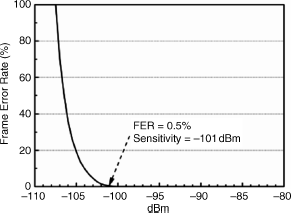
There are two other parameters [12], NHPIS ±45 and NHPIS ±30, which are included in CTIA format reports but receive little attention from antenna engineers. NHPIS stands for Near-Horizon Partial Isotropic Sensitivity. One integrates EIS between ±45°, the other one between ±30°. They can be calculated from the same set of test data used by the TIS formula.
(5.13) 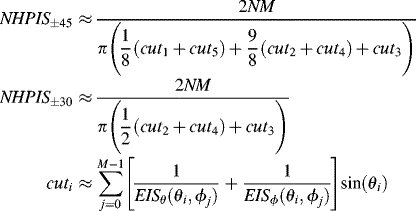
Shown in Figure 5.30 is a TIS test set-up. A phone is installed on the 3D rotation table without any cable attached. A base station simulator must operate in the two-port mode. Its output port is connected to the dual-polarized horn antenna, while its input port is connected to a link antenna near the phone. The EIS of both vertical and horizontal polarizations is measured by switching a SPDT switch. In this set-up, the position of the link antenna is not important, as long as it can keep the wireless link connected during tests.
Figure 5.30 Simplified block diagram of a TIS test set-up

5.2.3 Sensitivity Degradation Due to Interference
If a phone's antenna and its transceiver are well matched, the phone's TRP is mostly decided by its conductive power and the antenna's efficiency. However, normally, a phone's sensitivity is not solely decided by its conductive sensitivity and the antenna's efficiency. In a real phone, the peak EIS formula shown in Equation (5.10) needs to be rewritten as follows:
(5.14) ![]()
where the ![]() of Equation (5.10) is replaced by
of Equation (5.10) is replaced by ![]() . The radiated sensitivity of a phone is always worse or at best equal to the conductive sensitivity. The term for the degradation of sensitivity is “desense.” Desense means that something is desensitizing a receiver. Receivers often have filters on the front of their circuits to help prevent unwanted signals from getting to the receiver and damaging its operation. In the case of desense, however, the signal is often internal or within the allowable frequency band of the filter. Desense is mostly a problem for the RF engineer. For more information, refer to books on the design of RF circuits or systems [15]. Only antenna-related desense issues are discussed in this book.
. The radiated sensitivity of a phone is always worse or at best equal to the conductive sensitivity. The term for the degradation of sensitivity is “desense.” Desense means that something is desensitizing a receiver. Receivers often have filters on the front of their circuits to help prevent unwanted signals from getting to the receiver and damaging its operation. In the case of desense, however, the signal is often internal or within the allowable frequency band of the filter. Desense is mostly a problem for the RF engineer. For more information, refer to books on the design of RF circuits or systems [15]. Only antenna-related desense issues are discussed in this book.
Assuming the RF engineers have solved all the desense issues which can be measured in the conductive mode and the radiated sensitivity is still much worse than the specification, this means we have antenna-related desense issues. There are two dominant coupling paths which can cause desense. As shown in Figure 5.31, the path (I) is directly antenna-related. Some components, such as LCDs, camera modules, and DC/DC converters, are known to have high noise across a wide frequency spectrum and they introduce noise currents on the ground plane. In the absence of an antenna, those noise currents cannot affect a well-shielded receiver. When an antenna is installed, it is a different story. For most cellular antennas, the ground is part of antennas, so the noise will be picked up by the antenna. If those noises happen to fall in a phone's working band, the sensitivity of all channels will be affected. When that happens, a smooth inflation of EIS value across the whole band can be observed. For LCDs and cameras, the shield is the primary weapon in mitigating their effect. As LCDs and cameras are not required to work all the time, at least for 2G phones, so some level of desense can be tolerated. For some 3G phones, which support video calls, the desense issue must be handled more carefully. The primary noise source of a DC/DC converter is the μH coil inductor. Shielding, solid ground, and high frequency shunt capacitors can effectively mitigate desense caused by DC/DD converters.
Figure 5.31 Some causes of desense
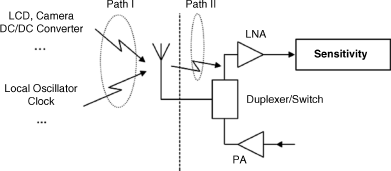
The signals from local oscillators and various clock synthesizers are also a potential source for desense. As both of them are periodical signals, their noises' spectrum composes a series of discrete peaks. Their impact on the receiver is mostly constrained in selective channels. Besides shielding, using stripline, which sandwiches signal traces between two ground layers in a multi-layer PCB, and placing two columns of grounded vias along the stripline, are all useful techniques to eliminate unwanted noise.
The path II shown in Figure 5.31 affects systems where receiver and transmitter operate simultaneously. Such systems include CDMA, WCDMA, and CDMA2000. For a time division multiple-access (TDMA) system, such as GSM and WiFi, as the transmitter and the receiver never work simultaneously, such a path is not an issue. Along the path (II), the high power signal from the antenna goes around the duplexer and goes back into the receiver link. This kind of desense is also called “self-jamming.”
Shown in Figure 5.32 is an example of incorrect routing. The gray area is the ground on the back side of PCB. All traces and components are on the front side. When measuring this board conductively, everything may just be fine, because there is no direct path between the trace to PA and the trace to LNA. When measuring it in the radiative mode, it is most likely that self-jamming will be an issue. As we have previously discussed, the ground of a monopole antenna is part of the radiator and a strong current exists on the edge of the ground plane. In the example shown in Figure 5.32, some part of the trace to LNA is routed along the edge of the ground, which can pick up the high power signal from the PA and cause self-jamming problems. If self-jamming is the root cause of desense, the level of sensitivity's degradation should correlate to the transmitting power. When the transmitting power is low enough, the desense seems to be fixed. To mitigate the self-jamming, the signal path of LNA must be well shielded.
Figure 5.32 An example of incorrect routing

In the CTIA test plan, only the TIS at low, middle, and high channels are fully measured. To catch the server desense issue, a relative sensitivity measurement must be done on all intermediate channels. Since some digital technologies have a very large number of intermediate channels, some channels may be omitted from actual testing provided there is no more than 500 kHz between any two successive intermediate channels. Shown in Figure 5.33 is the intermediate channel test according to the CTIA test plan. Based on the peak EIS of three fully tested channels, three segments pass/fail limit lines can be calculated. Each limit line is set to be 5 dB higher than the peak EIS of the corresponding reference channel. When measuring the intermediate channels, the transmitting power from the base station simulator is set according to the limit and the chamber positioner is moved to the location and polarization resulting in the best-radiated sensitivity according to the fully measured reference channel. For each channel, only one FER measurement is needed, the result is either pass or fail.
Figure 5.33 Illustration of intermediate channel test (Reproduced from CTIA — The Wireless Association®.)
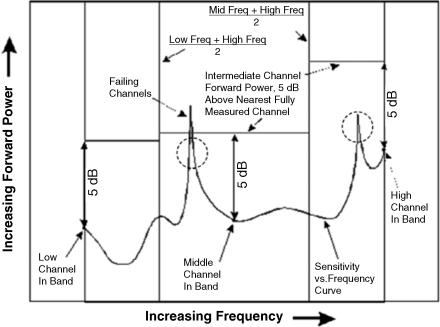
The curve shown in Figure 5.33 is an EIS result of a phone across all channels, which is not the intermediate channel test result. Two sparks marked by dashed circles are caused by desense. When doing an intermediate channel test, only the left spark can be detected and the right spark can pass the test without being noticed. If we want to fix these two sparks, the most likely suspects are local oscillators and clock traces.
5.3 Antenna Measurements in the Production Line
As antenna engineers, our job responsibilities include not only designing antennas but also accompanying antennas through the whole production process. If you work for a phone company, you are on the customer side of the business and you may not need to do all the hands-on works related to the production. However, it is still good to know what is going on and be able to give clear instructions to your counterparts. If you work for an antenna or an OEM (Original Equipment Manufacturer) company, you are on the vendor side and production measurements are certainly part of your job's responsibility.
In the production stage, a single model of an antenna can be manufactured in hundreds of thousands or even tens of millions. Some means of production control must be involved to ensure consistent quality. Some controls are mechanically related, such as dimension, visual quality, and antenna strength controls. Even if an antenna passes all mechanical inspections that does not mean it will work properly when it is installed in a phone. Therefore, an electrical inspection is necessary on the production line.
Whether 100% of antennas need to be tested or a sampling test is enough is the call of the customer. Normally, for primary antennas, a 100% test rate is appropriate. A sampling test is enough for most single band auxiliary antennas. The test equipments used in the production line are network analyzers. The scalar network analyzers (SNA), which is only capable of measuring amplitude, is good enough for line tests. SNAs are about half the price of entry level VNAs. Of course, if money is not an issue, VNAs also work fine. When using a network analyzer to design an antenna, we use a fixture made of a real phone. Each time we tweak the antenna, the fixture must be disassembled. On a production line, time is everything and the time spent in each test station is counted by seconds instead of minutes. Therefore, special antenna fixtures for antenna testing have been designed.
There are two ways of testing antenna modules. One is measuring the return loss (S11) and the other is measuring the transmission loss (S21). Designing a return loss fixture is quite straightforward. Most of the principles of designing R&D phone fixtures can be used here. For a production fixture, the most important consideration is consistency. Apart from the PCB and the necessary metal contacts, all the other components, such as the battery, the shielding box, and so on, should be excluded from the fixture. The life of a production fixture also needs to be considered. For example, some PIFA antennas, which are made of stamping metal, have built-in spring fingers serving as the contact mechanism. In a real phone, PCB pads are good enough to make a secure connection between a PCB and an antenna. If the same kind of pads are used in a production fixture, it is most likely that after several thousands of test cycles the fixture will be worn out. When making such a fixture, thin beryllium-copper pieces, which are cut according to the shapes of PCB pads, should be soldered on top of the pads. With the extra layer of metal, the life cycles of the fixture can be extended by several orders of magnitude. Pogo pins used in all phones have limited life cycles, so they shouldn't be used in production fixtures. For some phones, which have pogo pins on the PCB as the contact mechanism, spring fingers are a better choice when designing their fixtures.
If the relative position between an antenna and fixture varies, the antenna's response will change. Some alignment features, which keep an antenna in position, and some stopper posts, which maintain a constant distance between an antenna and a fixture, can all be used in fixtures' design. A good fixture should allow a well-trained operator to achieve a test cycle in less than 10 seconds.
It is quite difficult to guarantee that the fixture's connector is always at the sweat spot which can isolate the testing cable's influence, so some ferrite chokes should be used to minimize the possible impact from the cable. Touch the testing cable near the fixture with your hand; the antenna's response should be consistent with or without your hand's proximity.
For a return loss type fixture, shield boxes are not necessary. However, as antennas are radiating modules, any moving object should be kept out of the near field region of the antenna under test. Shown in Figure 5.34 is a simplified illustration of a production test set-up. The equipment of the set-up is a VNA. The testing cable, which connects the VNA and the fixture, is omitted in the illustration. The long board in front of the VNA is the fixture holder, which is secured on the test bench. The bench is also omitted in the illustration. One end of the holder extends out of the bench to provide a clear test environment for antennas. The test fixture is attached to the holder. The black module attached to the fixture is an antenna under test. A pressure beam provides the required contact force between an antenna and the fixture. Around the test fixture, there are three large semi-transparent boards; they form the keep-out fence. An operator should keep both hands outside the fence when the VNA is collecting testing data. Apart from the test fixture, everything else should be made of plastic, such as polycarbonate (PC) or nylon.
Figure 5.34 Simplified illustration of production test set-up (S11 type)
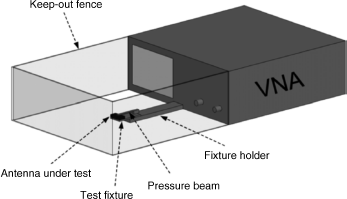
In any test, there are always some inherent fluctuations. The S11 measures the mismatch between the impedances of a source and an antenna. The point which has the minimum return loss is normally defined as the resonant frequency. A slight antenna's impedance variation may affect both the measured resonant frequency and the amplitude of the return loss. To improve the test consistency, the S21 type test was introduced. Shown in Figure 5.35 is an S21 fixture. The fixture is composed of a shield box and two probes. Two probes are connected to the VNA's ports through two coaxial cables. In an S21 fixture, an antenna under test has no galvanic contact with either probe. They are electromagnetically coupled.
Figure 5.35 Simplified illustration of production test set-up (S21 type)
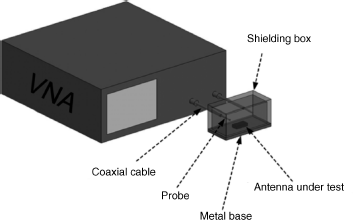
The principle behind S21 fixtures is the self-resonant modes. As is taught in electromagnetic courses [16–19], there exists a series of discrete eigenmodes for any resonators and strong resonances can only be excited at those discrete modes. An antenna is a resonator, so it also has discrete modes. If a resonator is lossless, the 3 dB bandwidth of any its resonant mode will be 0 Hz. The more lossy a resonator is, the wider the 3 dB bandwidth is. To improve the measurement's accuracy, we need a narrower bandwidth, thus we must decrease the overall loss in a test set-up. An antenna is a good radiator, which means it loses a lot of energy to the free space, at its resonant frequencies. By surrounding an antenna with a shielding box, all radiating paths are cut off and the antenna is converted to a resonator with little loss.
Shown in Figure 5.36 is data measured in an S21 fixture. The antenna is a single band antenna. When there is no antenna in the fixture, the transmission loss is around −50 dB. After putting in an antenna, the S21 reaches −10 dB at 2.17 GHz. The fixture shown in this example is a constructive coupling one. In such fixtures, an antenna functions as a relay. Without the antenna, the energy from one port can barely reach the other port. At the antenna's resonant frequency, strong currents are excited on the antenna element by the input port; the radiation from the antenna then reaches the output port.
Figure 5.36 Measured result of a S21 set-up, constructive coupling

It is also possible to design destructive coupling fixtures. On such fixtures, the resonant current on an antenna blocks the transmission between two ports. The S21 curve of a destructive fixture looks like an upside-down version of Figure 5.36.
No matter whether it is an S11 fixture or an S21 one, as a fixture is different from a real phone, it is almost impossible to get identical responses. A correlation must be established between them. Let's use a single band antenna to explain the process. Before we can set the pass–fail limit for a fixture, we must have a limit for the phone first. As shown in Figure 5.37, the thick horizontal line at −10 dB between 0.824∼0.96 GHz is the assumed limit. Sample 3 is the optimized antenna design. In this example the antenna has huge bandwidth; this is for the convenience of demonstration. In reality, managers love to shrink antennas' size until it marginally meets the specification. A group of samples, at least ten, must be prepared to carry out the correlation. Those samples are not randomly picked from the production line. They are purposely made to represent wide variations of antenna responses, and some samples must be failed samples. For convenience, only four samples are used in the example. Samples 1, 2 and 4 are all specially made ones. Samples 1 and 4 are failed parts. Sample 1 has the lowest resonant frequency and it fails at the high band edge. Sample 4 resonates at the highest frequency and it fails at the low band edge. Markers L1 to L4 are the four samples' low band edges, where the return loss is −10 dB. To pass the limit, the low band edge must be smaller than 0.824 GHz. Similarly, markers H1 to H4 are high band edges and they must be larger than 0.96 GHz to pass the limit.
Figure 5.37 Antennas' response measured on a phone

Shown in Figure 5.38 are the measured results of above four samples on an S11 fixture. An S11 fixture should give a similar response to a real phone. In this example, the response curves move higher. Marks F1 to F4 are the resonant frequencies, which are the lowest return loss points on respective curves, of the four samples.
Figure 5.38 Antennas' response measured on an S11 fixture
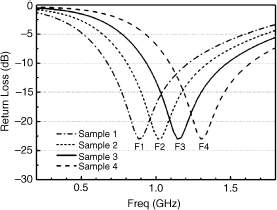
After collecting all the data, it is the time to carry out the correlation. In this example, the goal of the correlation is to convert the specification of the band limit on a phone, as shown in Figure 5.37, into a frequency range limit on a fixture. There are two lines in Figure 5.39. The left and right lines correspond to the low and high band edges respectively. Both X and Y axes are frequency ones. Let's look at the data line on the left. The X coordinates, L1 to L4, are band edge frequencies obtained from Figure 5.37 and the Y coordinates, F1 to F4, are resonant frequencies obtained from Figure 5.38. Plotting them in Figure 5.39 accordingly, we have four rectangular markers. A line can be drawn across these four markers. As has been shown in Figure 5.37, the high end of a fixture's limit is decided by a phone's low band edge. By interpolating from the line, it can be calculated that the low band-edge of 0.824 GHz corresponds to 1.28 GHz on the fixture. Similarly, the high band-edge of 0.96 GHz corresponds to the low end of the fixture's limit, which is 0.91 GHz in this example. The final fixture's limit is from 0.91 GHz to 1.28 GHz, which is the gray area shown in Figure 5.39. If an antenna's resonant frequency on a fixture falls in the range between 0.91 GHz and 1.28 GHz, it passes the limit. Otherwise it is a failed part.
Figure 5.39 Correlations between a phone and a fixture

In reality, four antenna samples are not enough. The actual measured data will never fall nicely in a straight line. Ten to twenty samples are more reasonable. Of course, more is always better. The 12 solid rectangles shown in Figure 5.40 are measured data of the low band edge. The solid line is obtained through linear regression, which can be done quite easily though Microsoft Excel. There is a feature called trend line in Excel, which can generate a straight line, its formula, and the R2 value. If the fixture functions well, all data points should evenly distribute around the trend line. The R2 value, which ranges from 0 to 1, is an indication of how good the regression line represents all discrete data points. If R2 equals 1, all points fall on the line. A R2 value higher than 0.90 means there is good correlation between the fixture and the phone. If the R2 value is too low, the fixture should not be used in the production line. In our case, the R2 value is 0.9822. By substituting the X value of 0.824 GHz into the formula, we get the high limit of the fixture, which is 1.129 GHz.
Figure 5.40 Correlation data of a real phone
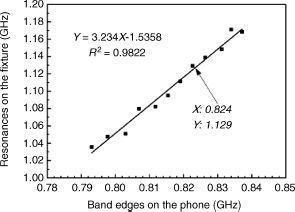
The samples shown in Figure 5.40 are better distributed than those shown in Figure 5.39, which are exaggerated to fit two lines into the same figure. A good set of correlation antennas should be evenly distributed along a relative wide frequency range. It should include a representative number of failed and passed samples, so the interpolating frequency is away from the end of the trend line.
Designing an S11 fixture is relatively easy. An antenna's response on an S11 fixture resembles the one on a phone quite well. It is a totally different story when designing S21 fixtures. Most antennas used in current phones are basically monopoles, so they need a ground to work properly at the frequency they are designed for. In an S21 fixture, an antenna resonates all by itself. In theory, an antenna designed as a quarter-wavelength monopole will resonate at the frequencies twice the one it is supposed to work at, in the half-wavelength mode. In practice, it is even more complex, as the resonant frequencies of an antenna's different modes depend on various aspects, such as the antenna's orientation, the distance from the antenna to the metal shielding box, the size of the shielding box, the position of probes, and so on. There is no clear step-by-step game book on this issue. If you really want to master designing S21 fixtures, a lot of trial and error and good patience are required. From the correlation point of view, the calculation processes of both S11 and S21 fixtures are pretty much the same.
Besides the correlation method, there is a rougher way to set the limit. By superimposing the responses of large quantities of passed and failed samples, a boundary can be drawn to separate them. As shown in Figure 5.41, the gray area defined by the upper and lower limit lines is the pass region. Only four antennas are used here to demonstrate the concept. If an antenna's response, such as sample 2 or 3, can pass the gray area without crossing the upper or the lower limit, the antenna is a passed unit. Obviously, samples 1 and 4 are failed ones. Most network analyzers have the limit line as a built-in feature, so it is not too difficult to implement it on a production line.
Figure 5.41 Set pass/fail region with upper and lower limits

The limit line method is especially useful when an antenna has wideband response. The dashed line shown in Figure 5.42 is an antenna's response on a phone. The return loss specification for this phone is better than −10 dB across both 0.824∼0.96 GHz and 1.71∼2.17 GHz bands. At the high band, two resonances are used to provide the required bandwidth. For this kind of antennas, using the correlation method is quite cumbersome. Two band edges of each band are not enough to represent an antenna's response. As marked in the illustration, the bump in the middle of the high band is a potential failure spot. When the return loss at this spot is higher than −10 dB, we get four −10 dB band edges at the high band instead of two.
Figure 5.42 Some issues with the correlation method
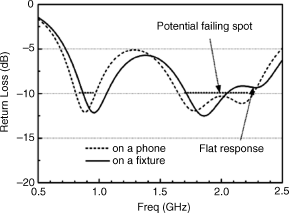
There is another possible issue with the correlation method. When measuring an antenna, which has several resonances in one band, some resonances may become illegible on a fixture. As shown in Figure 5.42, the highest resonance on the fixture is quite flat, which makes accurate frequency measurement a challenge. In such circumstances, the limit line method is a better choice. In practice, there are more ways to set up the pass–fail criteria. As long as they can separate good parts from bad ones and customers buy the idea, they are usable ones.
After setting the pass–fail limit and calibrating the network analyzer, can we be confident about the measured results? In fact, we still can't. For instance, how do we know a failed antenna is really a defective one, instead of a false alarm caused by a worn-out fixture? This is where gold units fit in. Whenever we set up a test station, some gold units need to be prepared with it. Some of the gold units are passed ones and some of them are failed ones. Whenever we have doubts about the fixture, we can retest these gold units. If the test results turn out to be different from the original ones, it is time to check the test station. On a production line, it is unnecessary to calibrate the network analyzer too frequently. The consistency of most state-of-the-art network analyzers is extremely good. Frequent calibration might cause more problems than it solves, as there is always some possibility of human error in the calibration process. One dedicated gold unit can be used to quick check the calibration of a test station. By saving the response curve of the dedicated gold unit when setting up the station, then comparing its measurement with the saved one, we can have a pretty good idea of how well the station is performing.
The final production test related to antenna is the phone radiate test. This test station normally is located at the end of a phone's assembly line. To reach this stage, the transceiver on PCB has been conductively measured and calibrated; the antenna has also passed its stand-alone test. The possibility of failure is quite low. However, failures still happen. For instance, the contact mechanism on either PCBs or antennas can be damaged during the assembly process; the matching components are missing or installed with the wrong value, the glue used in the underfill process spills over and covers the contact pad. These aren't pure hypothetical situations, they happen from time to time. This kind of failure is much more serious than the moderate degradation of an antenna's performance. If an antenna is outside the specification, a phone's performance gets a hit of a few decibels. Normally, people can't tell the difference. It is perceivable only at the fringe of a base station's coverage area. On the other hand, a failure that happens in the assembly process can easily introduce a degradation of more than 10 dB, which is noticeable to any customer. If such phones were shipped out, the damage to the brand and the loss associated with the logistic channel could be severe.
The aim of a phone's radiate test is to catch the abnormal in the assembly process. It should not be used to detect an antenna's performance degradation, which is the task of stand-alone antenna tests and is too time-consuming to be done in the final stage. In most circumstances, measuring the radiated power on a single channel is adequate. The station should be able to pick up some phones specifically prepared with different antenna-related defects. If the station does not do so, measurements at a few more bands might be necessary. Shown in Figure 5.43 is a set-up of a radiating test. A base station simulator is used to establish the phone call and measure the transmit power of the phone under test. The coupler can be either an antenna or a transverse electro-magnetic (TEM) cell.
Figure 5.43 Radiating test on a production line (Reproduced with permission from TESCOM Co., Ltd.)

When designing a coupler, there are two considerations. The primary consideration is the coupling coefficient's flatness at the test frequency. The secondary consideration is how strong the coupling is, of course, higher is better. The coupling coefficient equals the transmission loss, which can be measured through the equivalent two-port network composed of a phone fixture and a coupler. Shown in Figure 5.44 is the coupling of two different designs. Although the coupling of design #1 is stronger, design #2 is actually better, because it has a flatter response on the frequency domain. The response curve of a coupler is sensitive to the gap between a phone and its holder. Due to the loading effect of the fixture, the coupling curve of the same antenna might drift around. As a consequence, design #1 generates more measurement variations than design #2.
Figure 5.44 Coupling coefficient
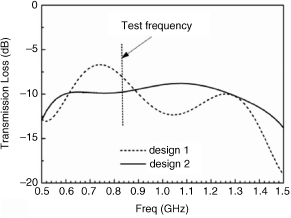
By offsetting the transmission loss in the base station simulator, the radiated power measured through a fixture should be equal to the conductively measured power. The final pass–fail limit of a fixture depends on how good the coupler is and how consistent the transmitting power is. As the functionality test in a production line, a ±3 dB limit should be fine. Of course, more time can always be taken to tighten the limit.
1. “Agilent Network Analyzer Basics,” http://cp.literature.agilent.com/litweb/pdf/5965-7917E.pdf. Retrieved 25 October 2010.
2. Icheln, C., Krogerus, J., and Vainikainen, P. (2004) Use of balun chokes in small-antenna radiation measurements. IEEE Transactions on Instrumentation and Measurement, 53, 498–506.
3. Icheln, C. and Vainikainen, P. (2000) Dual-frequency balun to decrease influence of RF feed cables in small antenna measurements. Electronics Letters, 36, 1760–1761.
4. Phillips, J.P. and Krenz, E.L. (1998) Spherical-scan near-field chamber for cellular phones. Proc. AMTA, Montreal, QC, Canada, pp. 37– 42.
5. “Applying Error Correction to Network Analyzer Measurements,” http://literature.agilent.com/litweb/pdf/5965-7709E.pdf. Retrieved 25 October 2010.
6. “Specifying Calibration Standards and Kits for Agilent Vector Network Analyzers,” http://cp.literature.agilent.com/litweb/pdf/5989-4840EN.pdf. Retrieved 25 October 2010.
7. Glen Dash, “How RF Anechoic Chambers Work,” http://glendash.com/Dash_of_EMC/Anechoic_Chambers/Anechoic_Chambers.pdf. Retrieved 25 October 2010.
8. Hemming, L.H. (2002) Electromagnetic Anechoic Chambers: A Fundamental Design and Specification Guide, Wiley-IEEE Press.
9. King, H., Shimabukuro, F., and Wong, J. (1967) Characteristics of a tapered anechoic chamber. IEEE Transactions on Antennas and Propagation, 15, 488–490.
10. “Satimo Stargate 64,” http://www.satimo.com/content/products/sg-64. Retrieved 25 October 2010.
11. “CTIA certification,” http://www.ctia.org/business_resources/certification/. Retrieved 25 October 2010.
12. “Test Plan for Mobile Station Over the Air Performance Rev 2.2,” http://files.ctia.org/pdf/CTIA_TestPlaforMobileStationOTAPerformanceRevision_2_2_2_Final_121808.pdf. Retrieved 25 October 2010.
13. “3GPP TS 34.114: User Equipment (UE)/Mobile Station (MS) Over The Air (OTA) antenna performance; Conformance testing,” http://www.3gpp.org/ftp/Specs/html-info/34114.htm. Retrieved 25 October 2010.
14. “Test Plan for CDMA Mobile Stations Rev 5.4,” http://files.ctia.org/pdf/CTIA_CDMA_Test_Plan_Rev_5.4.pdf. Retrieved 25 October 2010.
15. Gu, Qizheng (2005) RF System Design of Transceivers for Wireless Communications, Springer.
16. Iskander, M.F. (2000) Electromagnetic Fields and Waves, 1st edn, Waveland Press Inc.
17. Sadiku, M.O. (2009) Elements of Electromagnetics, 5th edn, Oxford University Press, USA.
18. Ulaby, F.T., Michielssen, E., and Ravaioli, U. (2010) Fundamentals of Applied Electromagnetics, 6th edn, Prentice Hall.
19. Buck, J. and Hayt, W. (2005) Engineering Electromagnetics, 7th edn, McGraw-Hill Science/Engineering/Math.
